|
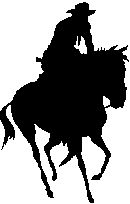
September-November
2007
|
BLACK
HORSE EXTRA
A Big Slice of the Cover Pie Hoofprints
Judging Books by Their Covers
The Colonel's Catch New Black Horse Westerns
"A picture is worth a thousand words" is a slogan unlikely to raise
the self-esteem of writers, but few in the Black Horse Western stable of
authors would deny their work has benefited hugely and regularly from fine
cover illustration by artists of international renown. The work of the prolific
Prieto Muriana and Salvador Faba, for example, has been appearing on the
books since the 1980s. The London publishers of the BHW line, Robert Hale
Ltd, can take pride in production work which has a reputation for attractiveness.
Covers have played a very large part -- if not the largest -- in earning
it.
So what is the worth of a good cover painting? Is it really a thousand
words?
We can reveal that, in monetary terms, a BHW cover is worth 31,500 of the
45,000 words it fronts. We compare here the fee for the use of the artwork
with the advance received by the writer of the novel, and we use the book's
word count as calculated by the publisher for typesetting purposes. Put
in another way, the beauty of a good cover might be only skin deep, but
it has a value that goes deeper than the eye can view -- about as deep as
112 of a BHW's 160 pages. Before authors rush from their keyboards to pick
up painting brushes and sign up for art classes, we pass on the warning
that it isn't easy, though we're sure no one looking at BHW covers would
have thought it was.
A while back, a BHW writer of
long standing told us, "I've just decided to take up painting again, and have
been spending my spare moments attempting to paint a cover for my
new BHW. The results are pretty poor, but I think it might improve
as I get back into my stride." A few months passed before he reported,
"I eventually abandoned my own first attempt to paint a cover -- I think
I was just being too ambitious in what I was trying to do. However, I've
completed another couple of paintings since then and am planning a somewhat
simpler western painting for some future epic. . . ."
BHW covers, like the novels themselves, accommodate a range of styles.
Some artists adhere to a camera-like capture of reality, while others are
more of the impressionist school. A nineteenth-century work by an impressionist
was famously dismissed by the art critic John Ruskin as a "pot of paint flung
in the public face". As far as we know, no one has said that about a BHW
cover! But clearly what is pleasing to one reader, or author, will not always
grab another. In this edition of the Extra, you will find a broad selection.
In our top story, we tell how one of today's busiest BHW cover artists
freed himself from employment in a pie factory to achieve his ambition to
be an illustrator of book jackets in several genres. Further on, BHW writers
take part in a panel discussion revealing their thoughts on the covers of
some of their books. Elsewhere, we have diverting Hoofprints to follow and
an article about the Schofield revolver to widen our knowledge.
As always, views and contributions are welcome. The address is feedback@blackhorsewesterns.com
|
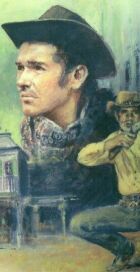
|

|
Introducing artist Michael Thomas
A BIG SLICE OF THE COVER PIE
A thought for the Extra . .
. one of my favourite artists, who produces some fantastic artwork for the
Black Horse Westerns, is Michael Thomas, artist/illustrator. I have attached one image
for you to see, but there are plenty on our BHW jackets. It might make for
an interesting article. . . .
Katy
Williams
Publicity, Robert Hale
Ltd
UNTIL about three years ago, the closest one of Black Horse Westerns' busiest
cover artists had come to the cowboy world was cutting up beef steak in a
pie factory. Which is not very close at all, given the meat pie is quintessentially
a British culinary delight.
Englishman Michael Thomas bears a passing resemblance to American actor
Anthony Starke and is around the same age. Starke is best known by western
fans as the gambling gunfighter Ezra Standish in the much-acclaimed television
series The Magnificent Seven, of which he said, "You show
up, put on cool clothes, shoot a gun, ride a horse, and you get to kiss the
girl. It's like every boy's fantasy."
Michael's fantasy was to be a commercial artist, and just as a western
series gave Starke a fine chance to do congenial work regularly, so it
has been lately for Michael. He is currently the artist responsible for
the biggest percentage of original BHW covers.
But for a while, Michael didn't look as though he was going to make it.
Born in Leicester in 1965, Michael had parents who were both teachers.
Auspiciously, his father, originally from Cornwall, taught art in a local
school.
"I’ve always loved painting and drawing and spent the best part of my
education doodling and looking out of the window," says Michael. "I did,
however, manage to secure a place at Loughborough Art College."
Michael admits he didn't stick with that, and it looked like his dream
was slipping away. "Instead, I found myself working in the butchery of the
local pie factory."
The experience drove him to look for a way into commercial art.
|

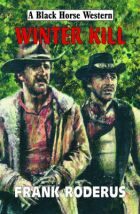
|
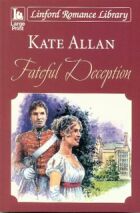
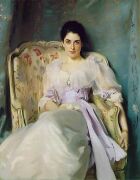
-- Sargent
|
"My first ‘commercial art’ position was as office junior in a point-of-sale
design team, but this involved very little illustration, which was where
my ambitions lay. I decided to leave to work for myself, became a freelance
artist, and gradually worked my way towards becoming an illustrator. This
was not as easy as it sounds! One of my first jobs was illustrating romantic
novels for large-print publication and it was through this that I obtained
my first western commissions, although at first these were few and far between.
Eventually, however, they grew to become a substantial part of my work,
and in the last couple of years I have taken up painting Black Horse Western
covers."
Artistically, his strongest influences have been late nineteenth-century
artists, such as John Singer Sargent and James McNeill Whistler. Both had
American parentage but pursued their studies and careers in Europe.
"Whilst painting realistically they also possess a very impressionistic
edge to their work," Michael says. "Other influences come from 1940s/50s
advertising, movie posters and western covers."
The covers of BHW books have an attractive, highly glazed look -- no doubt
designed to wear well under public-library conditions and the handling and
carrying that must typify the life of the much exchanged and borrowed book.
But readers who have examined Michael's covers closely will have noticed
the suggestion of a somewhat different texture to the original artwork. Michael
expounds on his materials and technique:
|
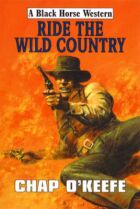
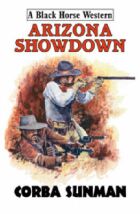
|

-- Whistler
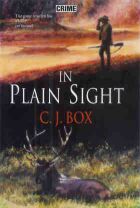
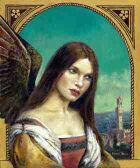
|
"I paint in acrylics, usually on a canvas paper designed for oils. This
has to be scanned and I have to be very careful about the way I lay the
colours down as the scanners do not always pick up half-tones and the finished
art work can end up looking very harsh. For example, a wash of white over
a colour always comes across as very patchy on the cover. I have to watch
that the finished work is not too dark and that I keep plenty of contrast
in the design, otherwise the illustration will be indistinguishable on the
finished cover.
"The texture of the paper can also sometimes cause problems with scanners
and my large-print westerns are now painted mainly on a flat watercolour
surface as these artworks are smaller than Black Horse Westerns."
BHW artists, just like BHW writers, find a critical camp ever-ready to
jump on errors in the accuracy of their work. A little basic research would
seem essential. Hollywood is invariably forgiven for taking liberties with
the details of historical backgrounds; a movie like The Comancheros
is given classic status, notwithstanding its confused meshing of the 1840s
with the 1870s. But the same potential market imposes different rules and
standards for the BHW writer or artist. Michael, like many others, does what
he can . . . and hopes.
"My main reference sources are stills from 1940s/50s/60s westerns, although
I refer to original nineteenth-century photographic sources. I keep files
containing faces and figures in interesting action poses from a wide variety
of magazines and the internet. I've also taken photos of western re-enactment
groups at living history events throughout the UK. These are a valuable
source of reference for my other work, too, as I illustrate a lot of historical
novels."
|
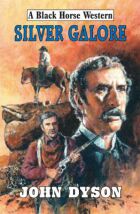
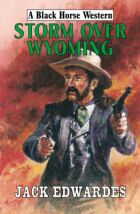
|
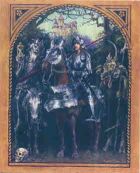
|
When creating covers for large-print editions, Michael reads the blurb
on the back of the Black Horse Western or other first printing. And his
comment on this contains a tip for the alert writer: "These are often still
fairly generic in appearance as there is often not a lot of detail in the
blurb."
Michael says his covers for the Black Horse Western series are all generic.
"I fit them in between my other work. Because of the high turnover of my
work, these covers have to be created very quickly, often within one day."
Does he have any preferences in subject matter?
|
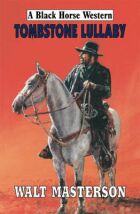
|
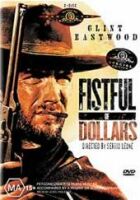
-- MGM
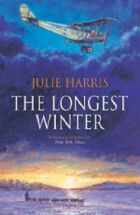
|
"My favourite covers are those involving the more authentic-looking cowboys
of the nineteenth century. Because of the comparative lack of reference
material from that period, the next best thing are some of the later western
movies where the clothing reflects the late nineteenth century and not
the period in which the film was created. I do have to admit Clint Eastwood
has appeared on far too many covers of mine, though this is true of other
illustrators besides myself!"
Despite the shrunken market for fiction, book publishers still need fresh
work for covers. We asked Michael what advice he would offer an aspiring
artist.
"Anyone starting in the field of illustrating for western book covers
will first have to become competent in figure drawing. With westerns in
particular, horses will also be another problem to a new artist, as the
time constraints hinder the production of a natural-looking animal. Figures
also can look stiff, especially if taken from poor reference materials.
It's always important to design a cover bearing these points in mind.
And don’t bite off more than you can chew."
BHW novelists will be sure to have their own opinions of Michael's work,
featuring so extensively and recognizably as the line's latest look. Does
Michael have views on the writers' endeavours?
He can offer only an apology. "Unfortunately, I actually get to read very
few westerns . . . I'm constantly reading proofs of other works as many
of my commissions do not include blurbs or synopses on which to base a design.
This can be very time-consuming. . . ."
-- KC
|
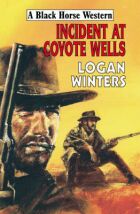
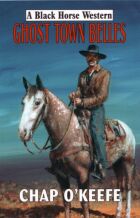
|
|
|
|
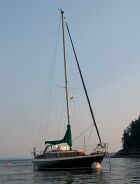
Fresh tack taken.
|
Impressions of a diverting kind
HOOFPRINTS
Matthew P. Mayo, of Maine, is sailing into new waters . . . as a
BHW writer. Matthew's first western novel, Winters' War, features
in the Hale lineup for October after being accepted for publication in
May. Matthew says, "My second, Wrong Town, was accepted in
June. I won't be able to keep up that pace as other duties and commitments
beckon, but I'll be back in the saddle soon." He tells Hoofprints he lives
with his wife, Jennifer, a professional photographer, plus two
dogs and a parakeet in an historic farmhouse. "We like to sail and kayak
and hike when we're not mowing our lawn, gardening, or shovelling snow.
When I'm not doing any of those things, I'm writing. When I'm not writing,
I'm a magazine and book editor. I work from home so I make my own hours
and I wouldn't change it for anything. Nothing like getting paid to work
with words whilst wearing an old ratty T-shirt and jeans!" He has been writing
for years, and has had published tons of articles, poetry and short fiction.
Winters' War is set in Wyoming in 1872, and the events are
set in motion eight years after a brutal range war.

|
|
|
Promotion of their books under a Black Horse umbrella does not appeal
to all of the writers by a long chalk -- at this website or on other Net
platforms. An author has forwarded to Hoofprints this comment made at the Grumpy Old Bookman
blog. Martin, an archaeologist
in Stockholm, wrote, "I really don't understand what imprints are for. Or
labels in the music industry. I can't even be bothered to check which publishers
have put out a certain book: why would I pay any attention to the imprint?
They must just lead to increased costs for the publishers. I keep track
of writers. Is the idea that I might read and like a book from, say, the
Snugglebunny imprint, and then blindly buy a lot of other Snugglebunny
books?" Hmm. . . . now there's feed for a Black Horse's thought! Black
Horse Extra, of course, is run independently of the books' publishers and
at no cost to them.
|

Choose by imprint?
|
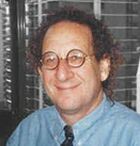 Niche-world strategy.
Niche-world strategy.
|
Publishing stategist Mike Shatzkin has
given a speech called "The End of General Trade Publishing Houses: Death
or Rebirth in a Niche-by-Niche World". Most literary agents, says Shatzkin,
think authors should spend two to ten hours a week promoting themselves
online. But novelist Anne Frasier said at Crimespace that she was
was "really worried" how self-promotion had become not only expected but
required, taking away her leisure time. At Ed Gorman's blog, Ed himself and
others, including western writers Bill Crider and Richard S. Wheeler,
agreed with her. But one reader pointed out the new climate had allowed him to make
contact with authors. And BHW writer Chap O'Keefe added, "Just yesterday,
the UK anthologist and bibliographer Mike Ashley, a veteran of his
craft if there ever was, emailed me: 'I didn't mention in my earlier email
but I had once tried to contact you something like 25 years or so ago, but
in those pre-internet days it didn't prove easy and I hadn't realized you'd
gone to New Zealand. Yesterday when I thought I ought to renew my search
it took just 30 seconds to find the link to you. Now that's progress!'"
|
|
|
During his searches, Mike Ashley also discovered the articles on
crime/western crossovers and Sydney J. Bounds in the March BH Extra.
"I went back and read them, and they were a delight. I'd known Syd for
well over 30 years, though only met him a few times, but he was always so
nice to talk to and so full of life. The last time I met him was only a
few months before he died. Although he was looking old and tired, that sparkle
hadn't gone from his eye and he still chatted away like old times. It is
so sad that so many have now gone from those days." Mike is an editor and
author with more than 60 books which have achieved in total more than a million
sales. Many of his books are devoted to reviving the popular genre fiction
of yesteryear. His next anthology, appearing in October in the US and Britain,
is The Mammoth Book of Dickensian Whodunnits.
|
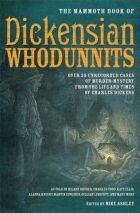 Editor's delight.
Editor's delight.
|
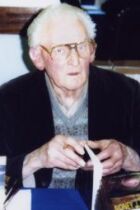 Pic: Cosmos Agency
Pic: Cosmos Agency
Last interview.
|
Literary researcher
Steve Holland alerted Hoofprints to a "final, exclusive interview"
with Sydney J. Bounds by Andrew Darlington at The Zone,
an SF website. In the 2005 interview, conducted before his move to Telford,
Shropshire, in May last year, Syd talked about his long career in most
branches of light fiction. He said: "I've finished number seven in the
Savage series of Robert Hale westerns, for the libraries. I'm just
trying to work out some kind of outline for number eight. But it's hard
going. There are so many thousands of westerns, trying to find anything
that remotely looks like something new is a headache. The last one I did
used the old 'fantasy quest' theme; I turned one of those into a western.
It worked all right. The books go direct into the libraries. They don't pay
much, but the point is you get something out of PLR [Public Lending Right
payments]. Plus there's a chance they'll be taken up by large-print editions.
I think there's three of my westerns that have gone into large-print so
far, and [agent] Phil Harbottle has started re-selling some of my
old 1950s crime books to large-print. They, of course, go into the library,
too, and then you get more PLR. Over a period it adds up. It's a useful
pension these days. And people are reading them, because when the PLR comes
through they provide a list of how many times it has been out, and -- what
is it? 2.4p each time anyone takes one out of the library. Which adds up."

|
|
|
Movie actor-director Kevin Costner found himself wondering whether
he would have to take out a new mortgage, so low was the level of response
in Hollywood when he proposed a new western. Costner's 1990 western, Dances
With Wolves, won seven Oscars, and he's determined to continue a
crusade to bring the genre back into fashion. He last rode in the saddle
before the camera for his 2003 movie Open Range, which was
based on a novel by the late Lauran Paine, who still has more BHWs
to his name (and pen-names) than any other writer. Costner plans to
direct his new project, for which he has completed the script. He says, "It's
just a good cowboy movie, about friendship and there's a code. It's written,
but people aren't dying to make them, so I'll just have to figure out how
to make it. Maybe I'll have to mortgage something. . . . They don't like financing them, but I'll figure it out. It's a genre
that's really worthy, really entertaining. I think they're hard to pull
off, and I like that.""
|
 Costner's crusade. Costner's crusade.
|
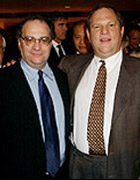 Brothers' backing.
Brothers' backing.
|
All is not gloom for the screen western. Genius Products, of
Santa Monica, a leading US home-entertainment distribution company, has
teamed up with RHI Entertainment (formerly known as Hallmark) to co-produce
"genre-specific projects", including up to 24 westerns and 24 "greatest
adventures". The first two westerns, Lone Rider and Prairie
Fever, and two adventures, Journey to the Centre of the Earth
and Dr Jekyll and Mr Hyde, have commenced filming. Under the
terms of the Genius/RHI agreement, Genius will have exclusive worldwide
home video and digital distribution rights for the co-productions while
RHI Entertainment will distribute the movies to television networks worldwide,
including ION TV. Genius's majority owner is The Weinstein Company, whose
co-chairmen are legendary movie-mogul brothers Bob and Harvey
Weinstein, who founded Miramax. Genius CEO Trevor Drinkwater
said, "This greatly expands our relationship with RHI Entertainment and
enhances our revenue opportunities with one of the worldwide leading producers
of quality movies and mini-series."

|
|
|
Veteran western novelist Elmer
Kelton says in his new memoir, Sandhills Boy: The Winding Trail
of a Texas Writer (Forge), "I have often been asked how my
characters differ from the traditional larger-than-life heroes of
the mythical west. Those, I reply, are seven feet tall and invincible.
My characters are five-eight and nervous." Born April 29, 1926, on the
Five Wells Ranch a few miles east of Andrews, Kelton knew the cowboy
way of life from the cradle onward. Many of the men he met in his youth
could recall the open range days, before barbed wire customarily set
the boundaries. Kelton says he simply wrote stories about what he knew.
"Insofar as possible I like to have a story grow out of some historical
reality, an event, a situation, a period of change in which an old
order is challenged by something new." He also writes, "Not all stories
have a happy ending. Life is not that kind to us."
|
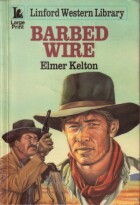 Cowboy life.
Cowboy life.
|
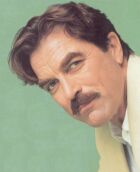 The good, the bad. . .
The good, the bad. . .
|
Between
acting and producing, movie star Tom Selleck mends fences and hauls
bales of hay on a 63-acre horse ranch in Ventura County, north of Los
Angeles. Selleck, originally from Detroit, has been an Emmy and Golden
Globe winner and is another who has strived to revive the western genre
with the likes of Last Stand at Saber River, Crossfire
Trail and Monte Walsh. He says, "Westerns are extremely
hard to get made, partly because they're expensive, and partly because,
for some reason, people in show business tend to distinguish them by their
genre. When a cowboy movie flops, they go, 'Westerns aren't working.' I
don't want to shock anybody; good westerns work and bad westerns don't.
I have a script ready to go based on Louis L'Amour's Empty
Land, but CBS wants to see how its new Lonesome Dove
project from Larry McMurtry will turn out first."
|
|
|
Northern California novelist Martin Cruz Smith set his
book Rose in a coalmining town in the nineteenth-century English
North, which must have posed him challenges in research similar to those
of the non-native western writer. C. S. Harris reports at her blog
that he told an interviewer, "I feel very bad about getting things wrong.
I've taken a few liberties, but I wanted them to be liberties I'd taken
deliberately. . .The worst thing in the world would be for some [reader]
you don't know to say, 'He's balled it all up. He doesn't know what he's
talking about.' …You can feel that small buzz of contempt on the periphery
of your subconscious, no matter how far away you are, the diminishing of
your own enjoyment and their esteem -- their trust really -- because there
is a relationship of trust between writer and reader, I think. You are walking
a curious tightrope in which you maintain your consciousness of reality, of
what is actually possible, which you can then manipulate. But if you get that
universe wrong, you are just manipulating stupidity." Meanwhile, a reader
and writer of western fiction who has wide working experience of cattle and
horses tells Hoofprints that one prolific American West native who enjoyed
a fine reputation for authenticity frequently "got it wrong" in his BHWs.
"I know that all is fair in fiction, but this bloke is one of the most authoritative writers of twaddle that
I have read. [He] is a master of the bluff but goes into too much
detail and trips himself up."

|
 Getting it right.
Getting it right.
|
 James ... good judge.
James ... good judge.
|
In reviewing a US reprint of Gary Lovisi's BHW West
Texas War, Texan James Reasoner said at his Rough Edges
site, "West Texas War is a good, solid, traditional western,
with an action-packed plot and a few nice twists that lift it out of
the realm of the formula western. As an aside, this is true of most of
the Black Horse Westerns, whose authors generally do a great job of finding
fresh variations on traditional plots." As clued-up readers know, James
has been the writing force over many years behind several western paperback
series appearing under publishers' house names, as well as a novelist
of note under his own byline. His kind words can be counted on as a fine
endorsement and were much appreciated. Later, at Westerns for Today, Russell Davis, a Spur and Western Heritage Awards judge, reviewed a March BHW, Sons and Gunslicks: "I've
talked a bit on this blog about how Robert Hale/Black Horse Westerns is continuing
the tradition of publishing fine westerns for the UK library market, and
this title is no exception. Part detective-story, part western [it] makes up in story
what it lacks in length and US distribution. There's a bit of a traditional
voice here -- almost too traditional in some ways -- but it's done in a smooth
way, and the author doesn't allow it to get in the way of the story at all,
which moves at an almost breakneck pace. Sent on a quest to find a dying
man's daughter, the main character, Joshua Dillard, quickly finds himself
embroiled in plenty of trouble. Worth the time of tracking it down, this
is a great example of why Black Horse continues to have success. . . ."

|
|
|
BHW writer Mike Linaker has no new titles to report to
the many fans of his Neil Hunter, Richard Wyler and John
C. Danner westerns. But Mike has been very busy producing action-adventure
blockbusters for Canadian paperback publisher Gold Eagle's Mack Bolan
series. He has recently completed a "SuperBolan" called Black Judas
-- "my title so it might change by publication," Mike writes. Just hitting
the store shelves is another SuperBolan, War Drums. And Mike's
next book in the associated Stony Man series, China Crisis,
is listed for publication in October 2007. Meanwhile, Ulverscroft have been
reissuing Mike's early, 1970s westerns between the BHW reprints in their
large-print Linford Western Library series. First out, with a fine cover
illustration by Prieto Muriana and now under the Richard Wyler
pen-name, was Brigham's Way. Another of the new Wyler editions
is Jacob's Road.
|
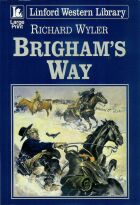 Opening the way.
Opening the way.
|
 Sky-high thrills.
Sky-high thrills.
|
Oh, the nostalgia! Keith Hetherington has been watching reruns
of some of the 22 episodes he scripted in the 1970s for TV cop show Matlock
Police, now appearing again on Channel 9 in Australia. Keith writes,
"Read the Extra and as usual enjoyed it. It's the variety I like. A newsletter
thing has never got me really excited, but I look forward to every Extra
-- and not just because it gives me a mention. I long ago lost all excitement
about seeing my name in print. Having said that, I have to admit I did
feel a bit of a lift when 'Written by Keith Hetherington' flashed on the
screen in the Matlock credits. First time I'd seen the show
since its initial telecast back in '72. I guess it's no wonder I could hardly
recall it." The summary for a later episode, Sky High, reads,
"A young widow and her son are held hostage by two extortionists who threaten
to blow Matlock sky high with stolen dynamite . . . ." For thrills that
can be received wherever you live, order Keith's newest BHWs, Once
a Ranger by Hank J. Kirby and None Faster by
Jake Douglas.

|
|
|
Newsweek magazine told its readers, "You can't write 41 books and not learn a few things."
It advised them to check out Elmore Leonard's 10 Rules of Writing,
which will be published shortly in handsome, gift-book form
with a leather and cloth cover and illustrated by Joe Ciardiello. The
author's official website said, "You may have the rules already but you don't
have the book and you're going to want one or three." Newsweek's favourite
among the rules was: "If it sounds like writing, I rewrite it." The magazine
also went on to give Leonard's selection for "My five most important books".
Among them was For Whom the Bell Tolls by Ernest Hemingway.
Leonard said, "Horses and guns. When I was writing westerns I'd read
a few pages to get in the mood. I still read his short stories." Leonard
westerns, including Hombre, were published in hardcover for
the British and Commonwealth market by Robert Hale Ltd.
|
 Master's rules.
Master's rules.
|
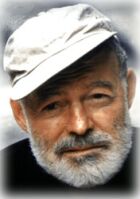 Hemingway revisited.
Hemingway revisited.
|
More Ernest Hemingway influence. . . . BHW writer Chap O'Keefe
reveals that aspects of his latest Misfit Lil story, Misfit Lil Fights
Back, were inspired by the famous Hemingway short story The
Killers, which was memorably adapted and expanded for a film thriller
in 1965 starring Lee Marvin, Angie Dickinson, John Cassavetes
and Ronald Reagan. In part, the blurb for O'Keefe's story reads, "Two
cold-eyed assassins rode in and gunned down horse rancher Sundown Sanders'
son Jimmie. And Jimmie made no move to run or defend himself,
despite Lil's stormy ride to bring him warning. Could devious boarding house
madam Kitty Malone or brutal gambling hall owner Flash Sam Whittaker
tell the truth about Jimmie's fatal resignation? Lil had to find out. " Hemingway and
movie buffs won't recognize the characters or setting, but some points of
the plot situation confronting the unorthodox Miss Lilian Goodnight may
be familiar. You can trust the independentally minded BHW heroine and her long-provoked
friend, scout Jackson Farraday, to produce new and exciting answers!
|
|

 David Whitehead
David Whitehead
 Chap O'Keefe
Chap O'Keefe
|
BHW writers share their thoughts
JUDGING BOOKS BY THEIR COVERS
Kearny shrugged. He
excused his refusal with a prejudice common among cow-business wranglers.
Black horses looked good on the outside but too many failed to live up
to the promise in performance. You did best picking only those who'd proven
themselves through and through.
Frontier Brides
Chap O'Keefe
IN the Black Horse Western novel quoted, hero Will Kearny declines the
offer of what is to him an unproven mount. He's aware the black is a
fine-looking animal, but he prefers to put his faith in a favourite chestnut
that has served him reliably.
When it comes to choosing books, do we follow Will's policy, basing selection
on the byline of an author with whose work we're familiar and perhaps
reading blurb, opening paragraphs or random extract? Or do we go for the
outer look, as represented by the cover?
Old adages aside, the message from publishers is that books are judged
by their covers, and that the cover art is therefore all-important. The
artist's payment for a Black Horse Western cover, sometimes done in a day,
amounts to more than two-thirds of the advance received by the book's
author for what can be 200 hours' work.
Generally, writers have no say in the covers their books are given. They
can be delighted. They can be horrified. And that's it. The decision on
what many consider the most important factor influencing a reader's motivation
to pick up their book is none of their business. The contract is clear:
"The publishers shall have the entire control of the publication and the
paper, printing, binding, jacket (including jacket design) and embellishments.
. . . "
Black Horse Extra asked a small panel of authors for their views and fears
on the fascinating topic of covers.
BH Extra: Do you think readers judge books by covers?
David Whitehead: Unquestionably. I know I do. A bright, technically
proficient cover always works for me. I remember many years ago Hale occasionally
used photographic covers -- usually a Colt, a lariat or a Stetson placed
against some kind of sackcloth, with a bit of shadow. That always looked
a mite flat to me and there was nothing about those covers that ever made
me want to read the books themselves -- even when the book in question
was Sierra Trail by Wes Calhoun, which was dedicated to me!
Chap O'Keefe: For sure the good cover can attract the uncommitted
reader in the first place, just as the bad one might cause him to give
a book a miss. But the same goes for titles, too, and some authors seem
willing enough to neglect the chances they are allowed in that direction, at
least with Hale. Once a reader's in a position to judge the book's content
. . . I don't know. A particularly good or bad cover might influence the
reader's mood and eventual verdict.
BH Extra: You say "good" and "bad" covers. Are there such categories,
or is it all simply a matter of artistic taste?
|
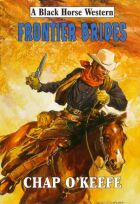
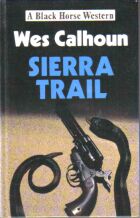
|
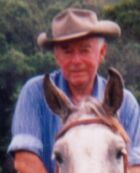 Greg Mitchell
Greg Mitchell
|
Greg Mitchell: A few artists who know me would probably tell you
that I know as much about art as a pig does about riding sidesaddle. But
I know what I like.
BH Extra: So, gentlemen -- as authors, can we take it covers influence
your own reading?
David Whitehead: I usually go for authors with whom I’m familiar,
or sometimes a particularly catchy title or pseudonym. But obviously,
the cover is the first thing I see. That dictates whether or not I pick
up the book for closer inspection and decide whether I really want to give
it a try. A good recent example was Stage Raider by Luther
Chance. I was so taken by the cover that I decided to read the book --
and ended up discovering a pretty good writer whose books I might otherwise
have passed up altogether.
Greg Mitchell: There is nothing like a well-painted horse to catch
my eye. Horses in the foreground add life and colour, and I would like
to see more on covers. I have seen viewers at art shows and have observed
first-hand how a good horse painting always invites a second look. I have
examined many BHW covers and can only recall seeing one poorly executed
portrayal of a horse, so have no doubt about the artists' talents. My brother
Mike is the official cartoonist for the Stockmen's Hall of Fame
newspaper in Australia and sells cartoons and paintings at the local markets
in Port Macquarie. At art shows where Mike's work was exhibited, the public
would be moving along a whole row of paintings and without fail everyone
stopped for a second look at the horse paintings. Mike was recently working
on one commission that would bring him in a couple of thousand dollars.
He can make almost as much in a morning selling prints and cartoons at Port
Macquarie markets than I make in a year's writing. For an artist, a BHW cover
would be only marginal in terms of profitability.
|
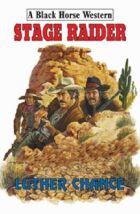
|
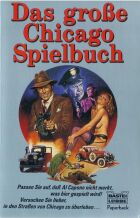
-- Salvador Faba
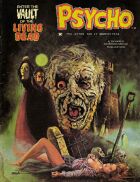 -- Salavador Faba
-- Salavador Faba
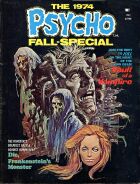 -- Prieto Muriana
-- Prieto Muriana
|
BH Extra: Which brings us neatly on to the subject of agency-supplied,
syndicated art; the so-called generic covers. As it's reported, the system
has been entrenched for decades that popular lines in genre fiction --
the thrillers, the romances, the westerns -- choose their covers from stock
offered by artists' agents to publishers world-wide. No bespoke tailoring
here; they're off-the-peg items. The artists produce stereotypical scenes,
often before the books they are to adorn are written and without reference
to them. The generic western cover has men, horses and guns -- with no
more distinction than the romance's close embrace, or the thriller's frightened
woman in dress and heels running down a shadowy street or through a dark
and menacing rural scene. What do we think about this?
Chap O'Keefe: The publisher buys the rights to use existing cover
artwork in his own market to make it possible to afford the work of top-quality
artists while keeping within the small budget he has for niche fiction.
From BHWs' outset in 1986, they've had brilliant covers from Continental
artists like Prieto Muriana, Salvador Faba and Jorge Longaron. They all
have long experience and are widely versatile across several genres. Their
BHW covers have already appeared, or will appear, on other westerns and in
other countries. The flip side is that it's not always possible to fit the
stock scenes to the stories they're supposed to illustrate. I'm more forgiving
on this one than many writers because I've experienced it from both sides
of the fence.
Back in the '60s, in Britain, I edited a chain of titles that
included four westerns a month and the covers were always paintings by Spanish
artists that had been used previously elsewhere. In any one month I might
have had thirty stock covers on hand, and still it wasn't possible to give
each of the four new books a cover that was totally suitable. Today, Hale
has to find covers for a half-dozen or more westerns a month. I sympathize,
and I'm not surprised when the cover subject or incident suggested in a title
isn't depicted, or a situation is apparently drawn with significant differences
to the way it's described in the book. The author's best hope in some circumstances
is that a generic, fits-any-western cover will be used, and that it will
be a good one. Thus I was delighted with Prieto Muriana's cover used on Frontier
Brides.
|
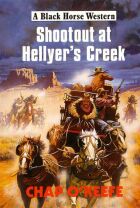
|
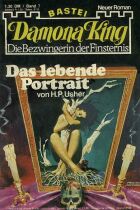
-- Prieto Muriana
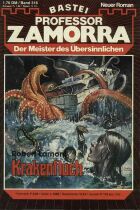 -- Prieto Muriana
-- Prieto Muriana
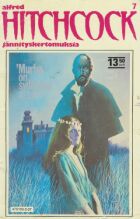 -- Prieto Muriana
-- Prieto Muriana
|
Sometimes a cover seems to fit perfectly. The Faba piece for the first
Joshua Dillard story, Shootout at Hellyer's Creek, was
one of these. Most recently, Hale hasn't found it easy to match art to
the Misfit Lil books, although at one time I was told the women on western
covers the company was offered were all Calamity Jane types. Then again,
the cover for my last non-Lil western, Sons and Gunslicks,
showed characters and a scene I couldn't recognize as matching anything
in the story I'd written either!
But the cover for Misfit Lil Fights
Back, just out, is a beauty -- again by Prieto Muriana. It would
be huge ingratitude to complain that the horse rider looks like she might
be a blonde under her hat rather than a brunette. Or that she isn't clad
in fringed buckskin. Or that her wonderful horse is a black rather than a
grey. Or that the rustling scene in the story took place by moonlight. It's
colourful artwork with heaps of movement and western atmosphere.
Greg Mitchell: Prieto Muriana is as good an illustrator as I have
ever seen. His cover for Warbonnet Creek is really good
-- skilfully painted, attractive to the eye and hinting at an interesting
story. Not only is he a good artist but he gets the details right. His
people, horses, scenery and town scenes are superb. My only complaint
is that there is not a horse in the foreground somewhere because this
artist paints them so well.
The artist for Outlaw Vengeance was good enough, but
to me the cover seems a little empty and didn't seem to say much.
The
same book's Linford large-print edition has a cover skilfully done, and
I have no complaint about the artist's work, but I do have a serious
complaint about the selection of this particular cover for a large-print
book. It is too dark.
My vision is poor so I can speak here as a user.
It is hard work for a person with defective sight to see the detail of a
dark picture. Bright, easily seen covers will attract a reader with vision
problems but dark covers give the unspoken message that reading this book
will be hard work. As one who knows, I can say that this cover, while really
good work, is a poor choice to attract visually impaired readers.
|
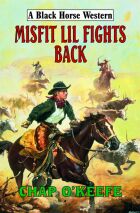
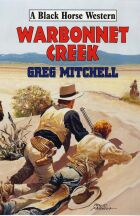
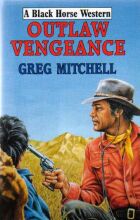
|
|
Red Rock Crossing has another dark cover. It is well done
and there is no question as to the artist's competency. But it is not
particularly eye-catching and gives no hint of anything exciting that
might happen in the book.
In general, the artwork on all these covers is good, but three of the
four show a certain similarity -- two figures in the foreground and minimal
background. I feel that a little more imagination might have resulted in
more interesting pictures.
David Whitehead: I don't have any special view on generic covers.
There is a need within a niche market like the western to produce the
book cheaply but well. A generic cover enables the publisher to do both,
and with a few infamous exceptions I think they work reasonably well.
Some recent Black Horse Western covers have left a lot to be desired.
It may not necessarily be the cover itself, but it’s the style in which
it’s painted -- it looks rushed or clumsy. . . . I’m not overly fond of
Draw Down the Lightning, for example, although I have to
say, I've seen efforts by the same artist I've liked less.
Chap O'Keefe: I know what you mean, David, but maybe there
are people out there who like that particular style of art, or are becoming
accustomed to it as a current BHW look. It's a little like the books themselves
-- readers are going to have preferences, and the line does cater for
an encouragingly wide range of tastes.
That's why I think the author's
name, making his or her other pen-names known, and building up a track
record and solid following -- as you have done -- are so important. It
could be something similar operates in the cover-art department.
When the newer author gets saddled with a cover he doesn't like,
his big worry has to be that a potential new reader will allow it to be
the deciding factor in whether he chooses the book, and if he does and reads
it, that the unsuitable cover will somehow colour his reception of the story.
I felt something of that with Sons and Gunslicks. I sometimes
wonder if the artists ever find it a worrying responsibility, dressing
a fellow creative worker's shop window.
|
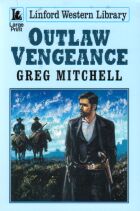
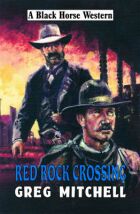
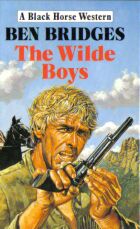
|
|
David Whitehead: Well, like any western writer who’s been
around long enough, I’ve had more than my share of Clint Eastwood and
James Coburn lookalikes over the years, though not for a while now. For
the large-print edition of Back With a Vengeance, I really
struck lucky when they used a cover painted by the wonderful Gordon Crabb.
He had originally painted it for the Transworld paperback version of Bowdrie’s
Law by Louis L’Amour. Pure class.
A quick aside here about blurbs, though. I think many people -- writers
in particular -- underestimate the importance of a good one. Sometimes
you can read the entire book in those few brief lines. “Clint goes here,
he meets Mr X, he’s ambushed, he rides on to that ghost town, and there
he meets an enemy from his past.” Where’s the point in reading the book?
You already know what you’re going to get! But a blurb that merely hints
at what’s to come, a blurb that asks questions but insists that you read
the book in order to find the answers, that works for me every time. It's
almost equally influential in helping me decide what to read and what to
pass up.
BH Extra: Greg has mentioned his liking for horses. To expand
it, are guns and women also attractive elements in covers, or otherwise?
|
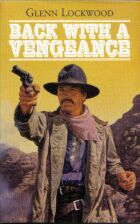
|
|
Greg Mitchell: I think guns have a rightful place on western
covers because there are gunfights in every story. As far as I can see, the
artists do a good job. Most of the weapons shown are Colt .45s and Winchester
carbines, but both were so popular that it is not wrong to show them when
there is no obvious time frame on the cover. Very occasionally a cap-and-ball
revolver is shown, so some artists try to be different. For variety's sake
they could show the odd Remington revolver, or Sharps or Springfield rifles,
but I would not be too critical.
David Whitehead: Obviously, the cover has to get the message across
that this is going to be an action-packed western, so for me the central
figure should always be male, preferably in some kind of action pose. I
don’t know that horses, guns or women are “attractive” as such, but they
all add a certain something, a promise of movement, of action, of romance
and/or sexual intrigue.
Chap O'Keefe: The cover for the large-print edition of Frontier
Brides was unquestionably attractive. By Longaron, an artist whose
work has been appearing on books since at least the '60s, it did all the
things David mentions. It showed a rider pursued by Indians. The story
had no Indians, but never mind . . . mounted up double behind the male rider
was a young lady with flowing blonde hair, wearing a sleeveless top with
a low neckline and displaying plenty of bare arm, leg and thigh. Whoever
chose it plainly had ideas along the right lines. Very appealing!
David Whitehead: Frankly, anything that helps to promote the book
is welcome, and the high standard of covers painted by the likes of Prieto
Muriana and the seemingly tireless Faba have really defined the look of
the modern BHW, in much the same way that they have defined the look of
the modern Cleveland Western in Australia. The Faba cover they used on my
book Tanner’s Guns cropped up again there, on a book called
Come to Comancheria by Emerson Dodge.
My North of the
Border, by an artist I’m not familiar with, turned up on another story by Emerson
Dodge, entitled Ride Gun for Radigan. It happens all
the time, and it’s fun to see where the same cover is going to turn up next.
|
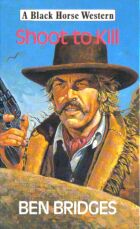
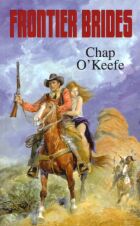
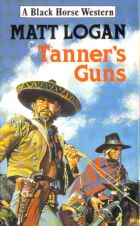
|
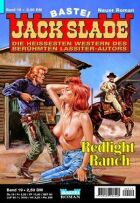
|
Chap O'Keefe: Sure is! The best fun I had was when US author
James Reasoner alerted us to a website running an unexpurgated version
of the cover for The Lawman and the Songbird, another Joshua
Dillard BHW which will be out again in October in large-print. A German publisher
had used the complete artwork for a book called Redlight Ranch
in a Jack Slade series. This had a half-naked "songbird" -- an element conspicuously
absent in the version used by Hale, where the topless fraulein in the
foreground is painted out! A darker area on the wall of the cabin, beginning
from the third log down, just happens to coincide with the top of the
woman's head. There is also an inexplicable mauve/pink area on the yard's
ground immediately above the byline and a darker piece of sky between
the two buildings above and to the right of a rather unlikely designed
open shutter. And on the German cover, an artist's signature was detectable
just to the right of the woman, under the title and above the gunstock.
It confirmed a gut feeling I had on first seeing the L &
S cover -- it's incomplete. The stance of the figure at the left
is somewhat awkward, almost as though his centre of gravity is in the
wrong place and he's about to topple over backwards. When the woman is
present, the composition and perspective seem to come right with the other
figures in the grouping becoming balanced framing.
BH Extra: Surely you can't expect public libraries to stock
westerns with nudity on the covers!
Chap O'Keefe: No, but a better solution here would have been
not painting out the woman, but painting on a shirt or something to make
her respectable to be seen in the libraries. It's a shame she got censored
entirely. Of course, the situation doesn't exactly occur in my book. But
then again, nor does it without the girl. And every time I've looked at
the BHW cover since seeing the German one, it has seemed strangely empty.
. . .
BH Extra: Do western readers want women on covers at all? A
few have suggested that females and the romance angle should be excluded
from the books altogether. Women were thin on the ground during the Frontier
West years.
|
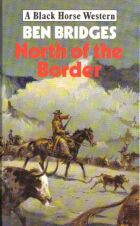
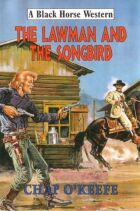
|
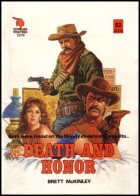
-- Salvador Faba
|
Chap O'Keefe: Yes, the undersupply has been well recorded,
but a glance through any of the usual research resources shows some great
characters were out there playing significant, colourful parts in the
story of their times. The journals and diaries of some of these women
have been hugely useful, too, perhaps because they had an eye for the detail
when men were busy fighting among themselves and with the conditions. Consequently,
I make it a rule that every O'Keefe BHW has at least two women characters
playing a prominent part in the story. Human relationships,
romance, passion . . . these make the world go round and are the raw material
of compelling fiction, westerns with strong, dramatic plots included. I'd like to see more covers that reflect this. BHW
covers often show no women when titles alone would indicate at least one
would be fitting. I was lucky with The Outlaw and the Lady and
The Gunman and the Actress, but missed out for The Sheriff
and the Widow, Frontier Brides, The Rebel and the Heiress, The Lawman and
the Songbird, Ghost Town Belles and Misfit Lil Rides In.
Having seen what publishers in other countries have used on westerns,
I wonder whether the lack might be due to a subtlety of briefing being
lost in translation. Possibly the Continental agencies have read, or been
told, romance and sex are secondary in BHWs. Though this is largely true,
I know from experience such instructions can become reduced when translated
to simple "yes" and "no" terms. Once a request for moderation has been
interpreted as a blanket "No sex please, we're British", it could be an agency over-willing
to please sets about removing all women from artwork with paint or computer
before submission. But that's straying into supposition. . . .
BH Extra: Nonetheless, they're intriguing thoughts and a good
note on which to wrap up the debate for now. Readers and other BHW authors
are invited to forward their opinions -- even conjectures! -- on any aspects
of cover artwork to feedback@blackhorsewesterns.com.
|
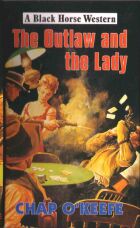
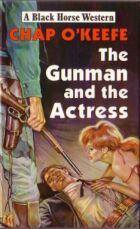
|
|
|
|
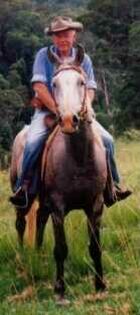
|
Greg Mitchell on the Schofield revolver
THE COLONEL'S CATCH
For
a moment they strained against each other and neither man had the advantage.
The outlaw [Hamel] was bigger but his opponent [Texas Ranger Ben Lawton]
was younger with equal strength and faster reflexes. Both knew that the first
one to get his gun pointed in the right direction would win the struggle.
Then luck swung the ranger's way. Though he dared not look, he could feel
that Hamel's gun was a Smith & Wesson Schofield. He moved his fingers
slightly, felt the barrel catch and pressed it.
To his great relief he felt the barrel and cylinder move
out of alignment with the standing breech. Releasing his hold on the temporarily
useless revolver, Ben threw the hardest left hook of his career.
Red Rock Crossing
Greg Mitchell
The Colt is predominant among
the revolvers that appear in western novels, but other makes had an important
role in the history of firearms in the American West. A BHW writer continues
an informative series with a look at the Schofield -- its antecedents and
its relatively short military life.
IN 1869 Smith & Wesson brought out the first large-bore American revolver
firing metallic cartridges. It was a top-break weapon using a .44 centrefire
cartridge. Previously the company had made bottom-break, rimfire revolvers
in .22 and .32 calibres and the big .44 was long overdue.
It was a large, single-action weapon with an eight-inch barrel. When the
catch was pressed, the barrel hinged downwards and exposed all six chambers
at once for loading. After all shots were fired the empty shells were thrown
out when the barrel was depressed and the weapon was ready for reloading.
The gun was an instant success with its .44 centrefire cartridges, but 400
of the first model were also adapted to fire the .44 rimfire used in Henry
and Winchester rifles.
Buffalo Bill Cody was one of the first frontiersmen to adopt the new revolver.
Its centrefire cartridge was later designated the .44 American. A Russian
duke hunting with the scout, was so impressed by Cody's guns that he convinced
the the Russian government to order thousands of the big .44s. The Russian
version had a slightly different .44 cartridge, a saw-handle grip and an extra
spur on the trigger guard. It has been said that the .44 Smith & Wesson
Russian was very accurate.
|

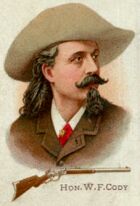
Buffalo Bill Cody
|
|
In 1871 the US Army considered adopting the Smith & Wesson to replace
its ageing mixture of Colt and Remington percussion .44s. As though distrusting
the innovations, the .44 Americans were issued to single cavalry troops
scattered throughout the country. It was a strange policy. One regiment might
have three different types of revolvers and several different carbines in
their ranks, and the system seemed to be a way of field-testing weapons before
making large-scale orders.
The top-break metallic cartridge revolvers had a speed of loading that
the percussion weapons on issue could not match and the incidence of misfires
was reduced to almost nil. That same year an army colonel named George Wheeler
Schofield (1833-1882) patented an improved barrel catch for the .44 American.
He also worked with Smith & Wesson to design an improved version of the
revolver more suited to army use. A contributor to a chat-room devoted
to cowboy and western action shooting reports, "As a macabre side note: he
blew his brains out with one of his revolvers."
It was 1875 before the first Schofields were made available to the cavalry.
They had the improved barrel catch, seven-inch barrels and fired .45 calibre
bullets. This meant that the new cartridge could be used in the Colt .45 revolvers
that the army was also acquiring. The Schofield cartridge could be fired
in the Army Colt .45 but the Smith & Wesson cylinder was too short for
the Colt round to be used in both types.
The Schofields, like the .44 Americans, also enjoyed success on the civilian
market where they were sold in a variety of barrel lengths.
Eventually the cavalry standardized their revolvers and selected the Colt
.45. They objected to the Smith & Wesson top breaks because when snapped
open they sometimes ejected unfired cartridges as well as the fired ones.
The Colt was slower to load and unload, but for cavalrymen there was less
chance of losing live cartridges. The Army phased out the Schofields and sold
them as surplus on the civilian market. The express company Wells Fargo bought
hundreds of these, had the barrels shortened to five inches and issued them
to their messengers.
|
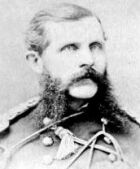
G. W. Schofield
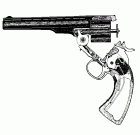
|
|
Some Schofields saw service on the wrong side of the law. Frank James was
known to carry one and some accounts say that his brother Jesse was carrying
one when he was shot by Bob Ford.
A claim was made that General Custer may have carried a Schofield at the Little
Bighorn where he met his end in 1876 but ammunition returns for that year
show none of these revolvers on issue to the Seventh Cavalry. Though a Schofield
could have been privately purchased, the story is contradicted by other claims
that Custer carried a pair of ivory-stocked British Webleys.
Though surpassed by modern technology, the Schofield .45 was a reliable,
accurate weapon that gave good service in its day. But that day passed quickly.
Production ceased in 1877 after approximately 9,000 were made. In 1878 the,
New Model No.3, a lighter, more modern weapon in various calibres, replaced
the American, Russian and Schofield models that had been based on the 1869
design.
-- Paddy Gallagher aka Greg Mitchell, whose next
BHW will be Killer's Kingdom.
|
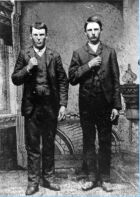
Jesse and Frank James
|
|
|
|
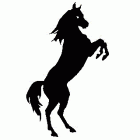
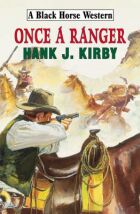
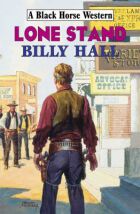
|
NEW
BLACK HORSE
WESTERN NOVELS
Published by Robert Hale Ltd, London
978
| Shootout at Fischer's Crossing
|
Daniel Rockfern
|
0 7090 7650 6
|
Haunted Pass
|
Lance Howard
|
0
7090 8270 5
|
Once a Ranger
|
Hank J. Kirby
|
0
7090 8361 0
|
Lone Stand
|
Billy Hall |
0
7090 8438 9
|
None Faster
|
Jake Douglas
|
0
7090 8446 4
|
Storm over Wyoming
|
Jack Edwardes
|
0
7090 8440 2
|
Sidewinder Flats
|
Walt Masterson
|
0
7090 8390 0
|
Lizard Wells
|
Caleb Rand
|
0
7090 8374 0
|
Remember Ketchell
|
Nick Benjamin
|
0
7090 8450 1
|
Dark Angel Riding
|
Logan Winters
|
0
7090 8455 6
|
Judge Colt Presides
|
George J. Prescott
|
0
7090 8458 7
|
Mist Rider
|
Luther Chance |
0
7090 8473 0 |
Where One Man Stands
|
Chad Hammer
|
0
7090 8319 1
|
The Last Great Gun
|
Clint Ryker |
0
7090 8425 9
|
No Second Chance
|
Clayton Nash
|
0
7090 8474 7
|
Winter's War
|
Matthew P. Mayo
|
0
7090 8479 2
|
Man of Blood
|
Lee Lejeune
|
0
7090 8477 8
|
A Place Called Jeopardy
|
Eugene Clifton
|
0
7090 8487 7
|
|
|
|
|
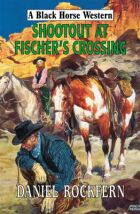
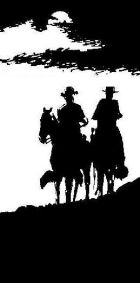
|
|
Black
Horse Westerns can be requested at public libraries, ordered at bookstores,
and bought online through the publisher's website, www.halebooks.com, or retailers including Blackwells, Amazon UK, WH Smith and VinersUK Books.
Trade inquiries
to: Combined Book Services,
Units I/K, Paddock Wood Distribution
Centre,
Paddock Wood, Tonbridge, Kent TN12 6UU.
Tel: (+44) 01892 837 171 Fax: (+44)
01892 837 272
Email: orders@combook.co.uk
For Australian Trade Sales, contact DLS Distribution Services, tradesales@dlsbooks.com
For Australian & New Zealand Library Sales, contact DLS Library Services, swalters@dlsbooks.com
DLS Australia Pty Ltd, 12 Phoenix Court, Braeside, 3195, Australia.
Ph: (+61) 3 9587 5044 Fax: (+61) 3 9587 5088
LATE NEWS: As of 17 August, copies of Misfit Lil Fights Back,
published on 31 July and mentioned here in Hoofprints and the Covers article,
were no longer obtainable from the halebooks site. Readers are advised that
limited stocks were still available from www.amazon.co.uk and its affiliates.
|
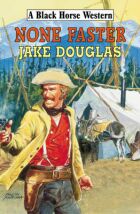
|
|
|
|
|